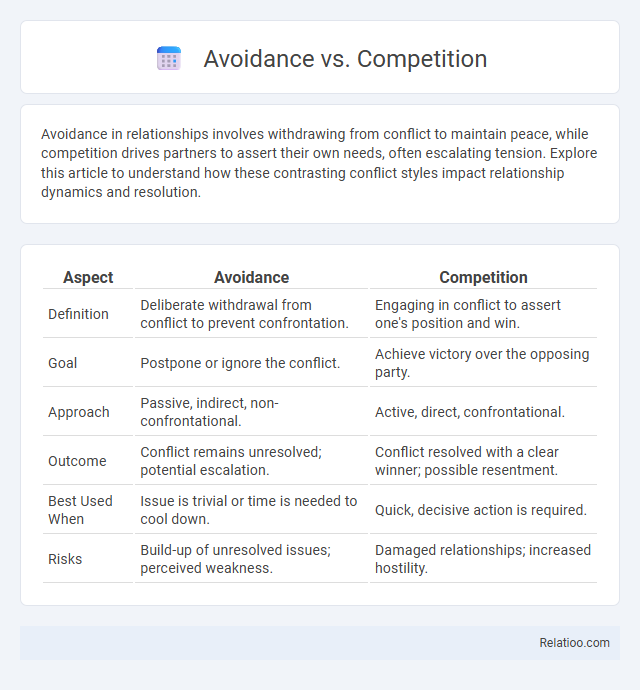Avoidance in relationships involves withdrawing from conflict to maintain peace, while competition drives partners to assert their own needs, often escalating tension. Explore this article to understand how these contrasting conflict styles impact relationship dynamics and resolution.
Table of Comparison
| Aspect | Avoidance | Competition |
|---|---|---|
| Definition | Deliberate withdrawal from conflict to prevent confrontation. | Engaging in conflict to assert one's position and win. |
| Goal | Postpone or ignore the conflict. | Achieve victory over the opposing party. |
| Approach | Passive, indirect, non-confrontational. | Active, direct, confrontational. |
| Outcome | Conflict remains unresolved; potential escalation. | Conflict resolved with a clear winner; possible resentment. |
| Best Used When | Issue is trivial or time is needed to cool down. | Quick, decisive action is required. |
| Risks | Build-up of unresolved issues; perceived weakness. | Damaged relationships; increased hostility. |
Understanding Avoidance and Competition
Understanding avoidance involves recognizing behaviors aimed at evading conflicts or challenges, often leading to missed opportunities for resolution or growth. Competition centers on striving to outperform others, driving motivation and innovation but potentially increasing stress and conflict. Balancing avoidance and competition requires assessing when to engage directly for success versus when to step back to preserve resources and maintain well-being.
Defining Avoidance in Conflict Resolution
Avoidance in conflict resolution involves deliberately steering clear of confronting the issue or opponent to prevent escalation and maintain peace temporarily. It contrasts with competition, where parties assert their positions aggressively to win the conflict, and accommodation, which entails yielding to others' demands to preserve harmony. Understanding avoidance helps identify when deferring conflict might protect relationships or allow time for emotions to settle before addressing the core problem.
What Is Competition in Interpersonal Dynamics?
Competition in interpersonal dynamics involves individuals striving to achieve their goals at the expense of others, often leading to direct conflict and assertive behavior. Your approach to competition may prioritize winning over collaboration, which can affect relationships and team cohesion. Understanding when to compete versus when to avoid or cooperate is crucial for balancing personal success with maintaining positive social interactions.
Psychological Roots of Avoidance Behavior
Avoidance behavior often stems from deep-seated psychological mechanisms such as fear, anxiety, and unresolved trauma that compel individuals to evade stressful situations. Competition can trigger avoidance when the fear of failure or negative evaluation outweighs the motivation to engage, highlighting avoidance as a protective response to perceived threats. Understanding the psychological roots of avoidance helps differentiate it from healthy assertiveness or strategic non-engagement, emphasizing the role of cognitive distortions and emotional regulation deficits in persistent avoidance patterns.
Motivations Behind Competitive Responses
Motivations behind competitive responses often stem from individuals' desire to assert dominance, protect resources, or achieve personal goals, driving them toward competition. Avoidance occurs when the perceived risks or costs of confrontation outweigh potential benefits, leading to withdrawal or passive behavior. Understanding these motivations clarifies why some choose competition to gain advantage, while others prefer avoidance to maintain stability or reduce conflict.
Effects of Avoidance vs Competition on Relationships
Avoidance in relationships often leads to unresolved conflicts and emotional distance, weakening trust and intimacy over time. Competition, by contrast, tends to create tension and power struggles, which can undermine cooperation and mutual support between partners. Your choice between avoidance and competition significantly impacts relationship satisfaction, with avoidance fostering withdrawal and competition escalating conflicts.
Pros and Cons: Avoidance Strategies
Avoidance strategies help You reduce immediate conflict by steering clear of confrontations, which can preserve relationships temporarily but may cause unresolved issues to fester over time. These approaches minimize stress and provide time to cool down, yet excessive avoidance can lead to misunderstandings and decreased communication effectiveness. Balancing avoidance with proactive problem-solving is crucial to maintain long-term trust and collaboration.
Pros and Cons: Competitive Approaches
Competitive approaches offer clear advantages such as driving innovation, motivating performance, and establishing market leadership by encouraging businesses to outperform rivals. However, excessive competition can result in resource wastage, increased stress, and potential conflicts that may harm long-term relationships and collaboration opportunities. You must weigh the benefits of competitive strategies against the risks of fostering adversarial environments that could undermine trust and sustainability.
Choosing Between Avoidance and Competition
Choosing between avoidance and competition depends on the specific context and desired outcomes in conflict resolution. Avoidance may prevent immediate confrontation but can lead to unresolved issues and increased tension over time, while competition encourages direct engagement to assert one's position but risks escalating conflict. Evaluating factors such as the importance of the issue, relationship dynamics, and long-term goals is critical to selecting the most effective strategy.
Building Healthier Conflict Management Skills
Avoidance in conflict management often leads to unresolved issues and increased tension, while competition prioritizes winning over mutual understanding, potentially damaging relationships. Building healthier conflict management skills involves integrating assertive communication and empathetic listening to address underlying concerns effectively. Developing strategies like collaboration and compromise enhances emotional intelligence and promotes sustainable resolution in both personal and professional settings.

Infographic: Avoidance vs Competition
 relatioo.com
relatioo.com